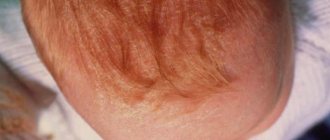The growth and development of a newborn baby is not easy. Young parents are looking forward to his birth, but after the long-awaited miracle is born, many problems and difficulties arise. A seemingly healthy child can become a source of constant worry for parents.
Unfortunately, all children get sick, it is inevitable. For the most part, emerging diseases quickly disappear under the influence of effective medications prescribed by a specialist. But sometimes the drugs turn out to be ineffective, and surgical intervention has to be resorted to.
One of the reasons that forces parents to turn to a surgeon is various types of obstruction in newborns. The term "obstruction" is most often found in connection with tear duct obstruction in newborns or intestinal obstruction in newborns. In both of these cases, surgical treatment may be necessary. We will talk about how these pathologies manifest themselves and what their causes are in this article.
Obstruction of the lacrimal duct in newborns
Tears are an important biological fluid needed to keep the eye moist and prevent dust and dirt particles from entering it. The tear is evenly distributed throughout the eye, and then goes through the tear ducts into the nasal passage. In newborn babies, obstruction of the nasolacrimal canal often occurs. The medical name for this pathology is dacryocystitis.
Obstruction of the lacrimal canal in a newborn is due to the presence of a special gelatin-like film. It is necessary during the intrauterine life of the fetus, since it performs a protective function, preventing the ingress of amniotic fluid. Normally, at the moment of birth and the baby’s first cry, the film breaks.
However, in some cases this does not happen, and the film clogs the duct, causing tears to accumulate and create a fertile environment for the development of infection. The cause of tear obstruction in newborns can also be pathology of the nose and soft tissues, resulting from injury or inflammation.
Etiology
The most common causes of volvulus in children are considered to be the early introduction of complementary foods, when the baby is not yet four months old, as well as a very sharp transition from breastfeeding to artificial formula. It is the unpreparedness of the baby’s digestive system for new food and its absorption that is the source of the formation of such a disease.
In addition, predisposing factors for the occurrence of intestinal obstruction in newborns include:
- surgical interventions on the abdominal organs previously suffered by the baby;
- increased mobility of the ligament that holds the intestines in a certain position;
- one mesentery for the large and small intestines;
- excessive ligament length;
- discrepancy in the size of some parts of the intestine, in particular the initial and distal;
- chronic constipation;
- insufficiency of the valve system;
- disruption of the functioning of nerve endings in a certain area of the intestine;
- intussusception is a process in which one section of the large intestine is introduced into the small intestine or vice versa;
- development of a hernia in the baby’s large or small intestine;
- intrauterine development of the fetus, which does not meet the norms;
- the formation of a malignant, benign or cystic neoplasm on the mesentery;
- severe helminthiasis.
However, in some cases, even specialists cannot find out the reasons for the appearance of volvulus in an infant. This is explained by the fact that the functioning of the digestive system can be disrupted by diseases of nearby internal organs.
How to treat tear obstruction in newborns?
If the diagnosis of obstruction in a newborn is confirmed, the doctor will most likely prescribe conservative treatment first. It will consist of regular massage of the lacrimal canal, as well as instillation of medications into the baby’s eyes. The massage is aimed at causing the gelatinous film to rupture under its influence.
For these procedures to have the desired effect, they must be carried out frequently - at least 10 times a day. If conservative treatment does not help solve the problem, probing of the lacrimal canal is performed. This is a simple and effective operation to remove blockage of the tear duct. After this procedure, it is recommended to perform a massage for prevention and use medicinal drops for some time.
Intestinal dysfunction in newborns
As a pediatrician, in my practice I often encounter disorders of the digestive system in infants - regurgitation, infant colic, functional diarrhea or constipation. In this article we will try to figure out how to help your child cope with these unpleasant conditions, when you need to see a doctor, with alarming symptoms.
Today we’ll focus on regurgitation in babies. Many parents know that almost all systems of a newborn child and infant during early childhood work unstable and are just beginning to function and gradually mature. Quite often this process lasts up to 7 or even 14 years, and in some cases up to 18. Endocrine, reproductive and metabolic problems. But at the same time, almost any organs and systems in infants are vulnerable.
Such functional disorders in infants include:. But the correct correction tactics when they appear determine the condition and proper functioning of the child’s digestive system in the future and the likelihood of developing diseases against the background of immaturity or improperly established interactions both between the organs of the digestive tract itself and with other systems of the body: nervous, endocrine, metabolic, and excretory.
All these conditions, in the absence of anatomical changes, are functional, but the future health of the baby depends only on us, parents and doctors. Functional disorders of the gastrointestinal tract, including regurgitation, are one of the most widespread problems among children in the first months of life. Reasons related to the mother:. Reasons related to the child:. Quite often, all these reasons, of varying severity, can be observed in one child who has suffered from hypoxia.
Regurgitation refers to the spontaneous reflux of gastric contents into the esophagus and oral cavity. Mostly regurgitation is observed in the first 4-5 months of life, much less frequently observed at the age of 6-7 months, after the introduction of thicker food - complementary foods, practically disappearing by the end of the first year of life, when the child spends a significant part of the time in an upright position, sitting or standing. .
The main cause of infant regurgitation is considered to be active swallowing of air during swallowing aerophagia, which occurs when:.
In children with persistent regurgitation with a score of 3 to 5 points, complications such as esophagitis, retardation in physical development, iron deficiency anemia, and diseases of the ENT organs are often observed. Alarming symptoms requiring attention:. Clinical manifestations of esophagitis are decreased appetite, dysphagia and hoarseness.
Infant rumination syndrome is a rare disorder characterized by the spontaneous return of stomach contents into the oral cavity by the child, followed by chewing and re-swallowing, which becomes a habit for the child. Often this condition in infants is called “chewing gum.” Subsequently, at an older age, it takes on the character of a habitual neurosis. Diagnostic criteria for infantile rumination:. This is a special type of repeated self-stimulation and self-satisfaction with which the child compensates for:.
In the presence of regurgitation, there is a need to use symptomatic positional postural therapy - changing the position of the child's body:. Postural treatment must be carried out not only throughout the day, but also at night, when the cleansing of the lower esophagus from aspirate is impaired due to the absence of peristaltic waves caused by the act of swallowing and the neutralizing effect of saliva.
When breastfeeding, first of all, it is necessary to create a calm environment for the nursing mother, aimed at maintaining lactation, to normalize the child’s feeding regimen, excluding overfeeding and aerophagia.
Sweet foods that increase gas formation in the intestines are excluded from the mother's diet: confectionery products, tea with milk, grapes, curd spreads and cheeses, non-alcoholic sweet drinks and meat and fish broths rich in extractive substances, onions, garlic, canned food, marinades, pickles, sausages .
Functional gastrointestinal disorders can occur as a result of food intolerance, most often an allergy to cow's milk proteins. In such cases, the mother is prescribed a hypoallergenic diet; whole cow's milk and all allergenic foods are excluded from her diet.
It is necessary to exclude overfeeding of the child, especially with free feeding, and sometimes cancel free feeding. When artificial feeding, it is necessary to pay attention to the child’s feeding regimen, to the adequacy of the choice of milk formula that corresponds to the functional characteristics of his digestive system, as well as its volume. If there is no effect from the use of standard milk formulas, it is advisable to prescribe anti-reflux products AR-mixtures, the viscosity of which increases due to the introduction of specialized thickeners into their composition.
Drug therapy - the use of antifoam agents Espumisan and Subsimplex and prokinetic agents trimedat, riabal. If the prescribed treatment methods are ineffective and persistent regurgitation persists, a complete examination of the child is necessary to exclude organic pathology: World of Moms: pediatrician subscribers blog.
Intestinal dysfunction is the failure of the large intestine to perform its functions: absorption, evacuation, excretion, as well as problems associated with the development of pathogenic microflora.
Intestinal obstruction in newborns
Another fairly common reason for visiting a specialist surgeon with a baby is intestinal obstruction in newborns. 25% of all cases of intestinal obstruction in newborns are congenital anomalies. In general, intestinal obstruction in newborns is of three types: chronic, acute and recurrent. Intestinal obstruction in newborns is most often caused by malformations of the intestine, as well as abnormalities in the development of organs located next to it.
Read more about obstruction and its causes
Obstruction is divided into chronic and acquired, which can develop in two cases:
- due to intestinal compression (strangulation);
- if the anus is closed by any tumor or neoplasm (obstructive).
Obstruction is also divided into partial and complete. In the first type, the obstruction is incomplete, i.e., a small part remains for passage. In the second case, the intestine becomes completely obstructed.
In infants, the main reasons that can cause obstruction are pinched or strangulated intestines. Another name for this phenomenon is intussusception.
In this case, part of one intestine enters the area of another. In boys, after six months of life, this phenomenon occurs more often.
The cause of intestinal volvulus is disturbances in the functioning of peristalsis, which children are susceptible to.
Problems in contraction of the intestinal walls may be due to excessive mobility of the colon and immaturity of the digestive system, or a tumor in the intestine may compress the intestine.
In addition, intussusception may occur due to adhesions in the child's abdomen after surgery. If the child is quite active, the intestines may wrap around the commissure during the jump.
Problems with intestinal patency in a child also consist in stool that is too tight for the newborn’s body.
As a result, the child’s feces block the intestinal lumen, which forms coprostasis, which causes obstruction.
Coprostasis can be observed with various congenital intestinal defects. However, not only an abundance of feces, but also worms, as well as some kind of neoplasm, can block the anus.
In the case of worms, additional intestinal spasm occurs from the toxins they secrete. In such cases, treatment begins with relieving intestinal spasms.
READ Treatment and surgery for intestinal necrosis
It happens that during the first two weeks of the child’s life, profuse vomiting and nausea appear.
This can occur due to a narrowing of the sphincter between the stomach and intestines (pyloric stenosis), which prevents milk from reaching these organs.
Birth defects that can cause obstruction in a child’s body include incorrect location and size of the intestines, and incorrect location of neighboring organs (pancreas).
Lack of potassium in the blood can also cause dynamic intestinal obstruction in a newborn baby.
Video:
The development of obstruction occurs due to impaired intestinal motor function. All this is possible after surgery, pneumonia or a child’s birth injury.
Also, this deficiency of the gastrointestinal tract is possible if the newborn is sick with an intestinal infection.
So, let's summarize the causes of intestinal obstruction:
- neoplasms, tumors in the intestines;
- chronic gastrointestinal defects;
- pinching, clamping of the intestine;
- adhesions in the intestines;
- complications after surgery;
- complication after a course of medication;
- coprostasis.
How to determine intestinal obstruction in newborns?
Acute intestinal obstruction always appears suddenly. Depending on which part of the intestine the obstruction is found in, symptoms may include bilious vomiting and bloating in the upper abdomen (if the obstruction is in the upper part of the abdomen), or vomiting with the smell of feces, constipation, bloating (if the obstruction is found in the lower parts of the abdomen). intestines).
Chronic obstruction usually develops when the congenital anomaly of the intestine is not clearly expressed. The main signs of such intestinal obstruction in a newborn are small weight gain, up to severe exhaustion, periodic vomiting and insufficient stool in small portions. The child also exhibits bloating.
Recurrent obstruction causes cramping abdominal pain, vomiting, constipation and gas formation in the intestines. Typically, the cause of recurrent obstruction is not clearly expressed volvulus of the large intestine or strangulated internal hernias.
Signs of the disease and its diagnosis
The signs of intestinal obstruction in a child are completely different. One of them is not having bowel movements after birth or passing bloody stools.
Loose stools and bloating from accumulated gases are possible. Intestinal bloating is also characteristic. In some cases it is visible to the naked eye.
In addition, a sign of obstruction is vomiting, which occurs some time after eating.
As a rule, the amount of vomit is much greater than the volume of milk that the child drank. After the stomach expands, the nausea interval may temporarily increase.
The main symptoms also manifest themselves externally - the child becomes restless, he experiences active sweating and pallor. In this case, quick and effective treatment is necessary.
READ Methods of cleansing the intestines with folk remedies and herbs
Absence, delayed bowel movements and sudden abdominal pain are the main symptoms of obstruction. As a rule, the pain is expressed in the abdominal area, it occurs suddenly, in contractions, and repeats every ten minutes.

The reasons for this lie in the fact that the intestines try to push the contents through, later the pain becomes constant because the intestinal muscles get tired.
The pain may improve on the second or third day, but this is not a good sign.
Despite the symptoms that appear, it is quite difficult to diagnose “obstruction”.
It is even more difficult to clarify its type and causes, because, despite the fact that X-rays exist, it is not difficult to confuse intestinal obstruction with anything else, since similar symptoms and disorders in the intestines occur in premature babies.
However, if you suspect any intestinal obstruction, you should immediately consult a doctor, as the problem is very serious and can be fatal.
First, the doctor examines the child to determine his overall health. An X-ray examination is then possible, which can reveal defects in the development or location of the gastrointestinal tract.
Sometimes the child's intestines are filled with air or barium is used to open the intestine further to see possible tumors or coprostasis.
This procedure is done if the parents contacted no later than twelve hours after the first symptoms appeared.
In more complex cases, a special method of surgical intervention is used - laparoscopy to examine intestinal volvulus and adhesions.
It is possible to use ultrasound, but only as an additional diagnosis in controversial cases.










